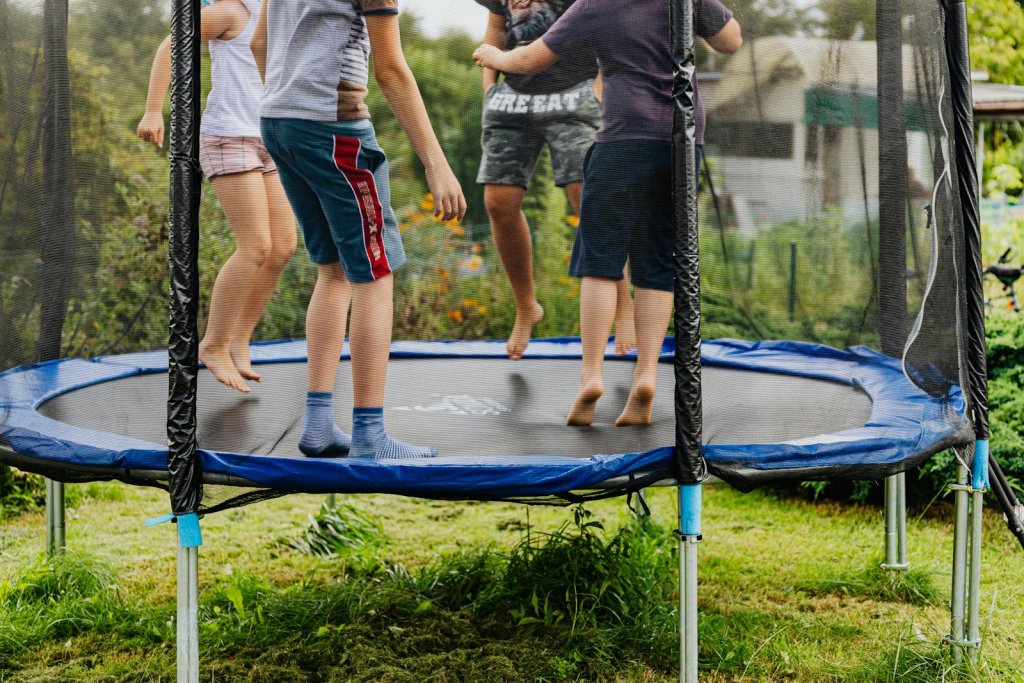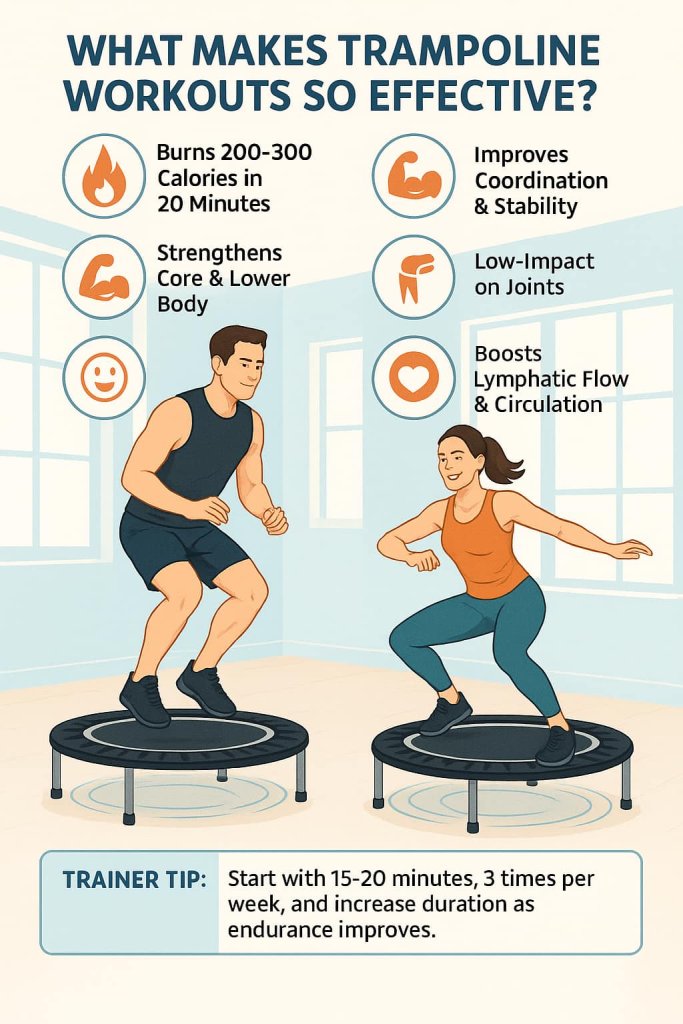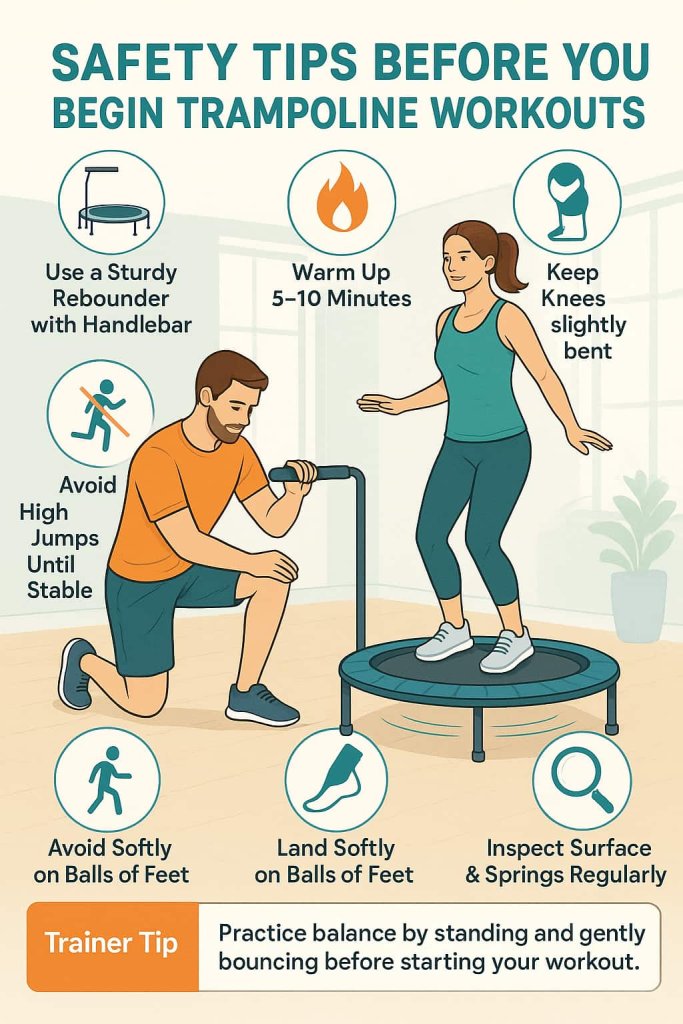Trampoline exercises are a fun, low-impact way to burn fat, build strength, and improve balance — all while protecting your joints.
Research from the Cleveland Clinic shows that mini-trampoline (rebounder) workouts elevate heart rate, improve coordination, and burn up to 12 calories per minute. That’s similar to running, but with far less strain on knees and hips.

Trampoline workouts are growing in popularity because they combine cardio, stability, and strength training in one compact, enjoyable session. Whether you’re a beginner or advanced athlete, these 15 exercises can help you torch fat, tone muscles, and boost energy from the comfort of your home.
What Makes Trampoline Workouts So Effective?
Mini-trampoline workouts recruit multiple muscle groups across the core and lower body, improve balance, and reach moderate-to-vigorous intensity while staying low-impact.

Key benefits include:
- Burns 200–300 calories in 20 minutes
- Strengthens lower body and core
- Improves balance and coordination
- Reduces joint stress compared to running
- Enhances lymphatic flow and circulation
- Boosts mood through endorphin release
Trainer Tip: Start with 15–20 minutes, 3 times per week, and progress gradually to 30–40 minutes as endurance improves.
Safety Tips Before You Begin

Before starting any trampoline exercise routine:
- Use a sturdy rebounder with a handlebar if you’re a beginner.
- Warm up for 5–10 minutes with light jogging or stretches.
- Keep your knees slightly bent to absorb impact safely.
- Land softly on the balls of your feet to protect joints.
- Avoid high jumps until your balance improves.
- Always check your trampoline’s springs and surface for wear.
Trainer Tip: Practice balance by standing and gently bouncing before starting intense moves.
15 Best Trampoline Exercises
Each move below includes the why it works, muscles worked, how to do it, and a trainer tip to ensure safe, effective performance.
1. Basic Bounce
Why it works:
The basic bounce is the foundation of all trampoline workouts. It helps you master balance, rhythm, and body control while gently elevating your heart rate. Because every bounce engages your stabilizer muscles to keep you centered, this move strengthens your core and lower body while enhancing neuromuscular coordination. The elastic surface also minimizes joint stress, making it safe for all ages and fitness levels.
Muscles worked: Core, quadriceps, calves, glutes, stabilizers.
How to do it:
- Stand upright on the trampoline with feet hip-width apart.
- Keep your knees slightly bent and your abs engaged.
- Begin by pushing through your toes to lift 2–3 inches off the mat.
- Land softly, allowing your knees to absorb the rebound.
- Continue bouncing rhythmically for 1–2 minutes, breathing naturally.
Trainer Tip: Don’t jump high — focus on control and posture. Imagine “floating” rather than bouncing aggressively. Keep your head neutral and your gaze forward.
2. Jog in Place
Why it works:
Jogging in place on a trampoline offers an excellent cardiovascular workout while reducing impact stress on your knees and hips compared to treadmill running. It improves circulation, endurance, and coordination, helping you warm up your body before intense moves.
Muscles worked: Quads, hamstrings, glutes, calves, and core.
How to do it:
- Start with a gentle bounce.
- Begin alternating your legs as if jogging slowly in place.
- Lift your knees slightly while maintaining a soft bounce.
- Pump your arms naturally for momentum.
- Continue for 45–60 seconds, maintaining steady rhythm and breathing.
Trainer Tip: Keep your chest up and shoulders relaxed. If you’re new, reduce bounce height to improve stability until your balance improves.
3. Jumping Jacks
Why it works:
A trampoline version of the traditional jumping jack delivers the same cardiovascular and coordination benefits, but with less joint strain. This full-body move elevates your heart rate quickly and builds endurance while sculpting your shoulders, legs, and glutes.
Muscles worked: Legs, glutes, shoulders, calves, and core.
How to do it:
- Begin standing tall with arms by your sides.
- Jump feet outward while raising arms overhead simultaneously.
- Jump back to the starting position and repeat rhythmically.
- Perform 20–30 controlled repetitions.
Trainer Tip: Land softly on the balls of your feet and avoid locking knees. Breathe out as your arms and legs extend, and in as you return to start.
4. High Knees
Why it works:
High knees build aerobic endurance and strengthen the core by forcing your abdominal and hip flexor muscles to lift your legs rapidly. It’s an effective calorie-burning movement that also trains coordination and timing.
Muscles worked: Core, quads, hip flexors, glutes.
How to do it:
- Start bouncing lightly.
- Drive one knee toward your chest, then quickly switch to the other.
- Maintain a brisk tempo while keeping your torso upright.
- Perform for 30–45 seconds per round.
Trainer Tip: Keep your knees at waist height or higher for intensity. Engage your abs and avoid leaning backward or rounding your shoulders.
5. Butt Kicks
Why it works:
Butt kicks promote hamstring flexibility and improve circulation in the lower body. They also strengthen posterior-chain muscles (glutes and hamstrings), which balance out front-dominant leg training.
Muscles worked: Hamstrings, calves, glutes, and core.
How to do it:
- Start bouncing gently in place.
- Alternate kicking your heels upward toward your glutes.
- Maintain small, quick bounces for 30–60 seconds.
Trainer Tip: Stay relaxed through the upper body. Keep your core tight to stabilize your spine and prevent excessive arching.
6. Side-to-Side Hops
Why it works:
This movement enhances lateral coordination — a key component often missed in forward-only cardio like running. It trains ankle and hip stability while challenging balance and agility.
Muscles worked: Glutes, quads, obliques, calves, adductors.
How to do it:
- Begin with feet together in the center of the trampoline.
- Hop 6–8 inches to the right, then immediately back to the left.
- Keep your knees bent and chest upright.
- Continue for 45 seconds, maintaining rhythm.
Trainer Tip: Land softly and keep movements compact. Imagine pushing the mat sideways under your feet.
7. Jump Squats
Why it works:
This power move combines muscle toning and cardio training. The trampoline’s resistance increases leg activation while its soft surface cushions your landings, reducing stress on knees.
Muscles worked: Quads, glutes, hamstrings, calves.
How to do it:
- Lower into a squat with hips back and chest tall.
- Push through your heels and explode upward, extending fully.
- Land softly into a squat and repeat for 10–15 reps.
Trainer Tip: Control your landings — never lock your knees. Use a moderate jump height to maintain joint safety and power efficiency.
8. Twists
Why it works:
Trampoline twists build rotational strength, improve spinal mobility, and enhance core control. The constant tension during twisting strengthens obliques and helps improve athletic coordination.
Muscles worked: Obliques, abs, lower back, quads, and glutes.
How to do it:
- Stand tall with feet together and arms at chest level.
- Jump slightly and twist your hips and legs to one side while keeping your shoulders facing forward.
- Alternate sides with each bounce.
Trainer Tip: Keep your movements smooth and controlled — the goal is to rotate from your core, not swing your knees or arms wildly.
9. Jump Rope Simulation
Why it works:
This mimics the classic jump rope move to improve coordination, agility, and endurance. The trampoline’s recoil increases calf engagement and supports longer training sessions without fatigue.
Muscles worked: Calves, shoulders, forearms, and core.
How to do it:
- Begin with small rhythmic bounces.
- Rotate your wrists as if spinning an invisible rope.
- Keep jumps light and quick, landing on the balls of your feet.
- Continue for 45–60 seconds.
Trainer Tip: Keep your elbows close to your sides and wrists relaxed. This keeps rhythm efficient and prevents shoulder strain.
10. Front-to-Back Hops
Why it works:
Enhances proprioception and spatial awareness — important for athletes and anyone improving balance. It builds reaction speed and agility while strengthening stabilizers.
Muscles worked: Legs, core, stabilizers, calves.
How to do it:
- Start at the trampoline’s center.
- Hop forward about 6 inches, then hop back to your starting position.
- Repeat smoothly and continuously for 30–45 seconds.
Trainer Tip: Engage your abs and land with soft knees to protect joints. Focus on balance over speed.
11. Tuck Jumps
Why it works:
An advanced plyometric exercise that increases explosive power and core control. Tuck jumps engage fast-twitch muscle fibers and raise heart rate rapidly for serious calorie burn.
Muscles worked: Abs, quads, hip flexors, glutes.
How to do it:
- Begin with a small bounce for momentum.
- Jump upward, pulling your knees toward your chest.
- Land softly with knees bent.
- Perform 8–10 controlled reps.
Trainer Tip: Focus on precision — keep your chest tall and core tight to maintain alignment mid-air.
12. Single-Leg Bounce
Why it works:
Improves balance, ankle stability, and proprioception (body awareness). This movement enhances coordination for athletes and supports rehabilitation for weaker legs.
Muscles worked: Glutes, hamstrings, calves, and core.
How to do it:
- Stand on one foot with the other lifted slightly off the mat.
- Engage your core and begin gentle mini-bounces for 30 seconds.
- Switch legs and repeat.
Trainer Tip: Use a balance bar or wall if needed. Keep your gaze fixed ahead and focus on ankle control rather than jump height.
13. Jump Lunges
Why it works:
A dynamic lower-body move that builds strength, stability, and explosive power while improving balance and coordination.
Muscles worked: Quads, glutes, hamstrings, calves.
How to do it:
- Start in a lunge position with one foot forward.
- Explosively jump up, switching legs mid-air.
- Land softly with the opposite leg forward.
- Repeat for 10–12 reps.
Trainer Tip: Keep your front knee aligned with your toes and core braced throughout. Avoid slamming your back knee into the trampoline.
14. Core Crunch Bounces
Why it works:
This seated core exercise enhances abdominal endurance and stability. The gentle rebound motion targets the abs and hip flexors while reducing strain on the lower back.
Muscles worked: Abs, hip flexors, and lower back.
How to do it:
- Sit on the trampoline with knees bent and feet lifted slightly off the mat.
- Lean back slightly, engage your core, and begin small bouncing motions.
- Bring your knees toward your chest as you bounce.
- Perform for 30–45 seconds.
Trainer Tip: Keep movements small and controlled. Focus on breathing — exhale as you contract your core and inhale as you extend.
15. Cool-Down Bounce
Why it works:
A gentle bounce helps transition your body from exertion to recovery. It lowers heart rate, enhances circulation, and promotes relaxation while flushing out lactic acid buildup.
Muscles worked: Full body, especially legs and core for balance.
How to do it:
- Stand tall and bounce gently for 2–3 minutes.
- Gradually decrease bounce height over time.
- Keep breathing deep and steady.
Trainer Tip: Use this cool-down phase to reset your posture and stretch your calves, quads, and shoulders afterward for recovery.
Sample Trampoline Workout Routine
| Level | Duration | Routine |
|---|---|---|
| Beginner | 15–20 min | Basic Bounce, Jog in Place, Side Hops, Cool-Down |
| Intermediate | 25–30 min | Jump Squats, Twists, High Knees, Butt Kicks, Core Crunches |
| Advanced | 30–40 min | Jump Lunges, Tuck Jumps, Jumping Jacks, Front-to-Back Hops |
Common Mistakes to Avoid
- Jumping too high (increases risk of imbalance)
- Locking knees on landings
- Ignoring warm-up or cool-down
- Not tightening core during bounces
- Overtraining without recovery days
FAQs About Trampoline Workouts
1. Are trampoline exercises safe for beginners?
Yes. Start with gentle bounces and progress gradually. Use a handlebar for added safety.
2. How many calories can I burn in a trampoline workout?
According to ACE Fitness (2024), about 200–300 calories per 20-minute session depending on intensity.
3. Can trampoline workouts replace running?
Yes, for many people — trampolining provides equivalent cardio benefits with lower joint stress.
4. Is it suitable for seniors?
Absolutely. Rebounding improves balance and joint mobility, especially when performed on a stable surface with support.
5. What equipment do I need?
A quality mini-trampoline (rebounder) with strong springs, non-slip surface, and optional balance bar.
6. How often should I do trampoline workouts?
3–5 times per week, with at least one rest day between sessions.
7. Can trampoline workouts help with lymphatic drainage?
Yes. Gentle bouncing stimulates the lymph system, promoting detox and immune support.
Conclusion
Trampoline exercises offer a unique mix of fun, fat-burning cardio, and joint-friendly strength training. Whether your goal is to lose weight, improve balance, or simply move more, a rebounder can help you achieve results in less time — and with more enjoyment.
Start small, stay consistent, and bounce your way to better fitness.
References
- Posch et al., 2019 — Mini-Trampoline Training Improves Balance & Functional Mobility (Older Adults), IJERPH
- ACSM Position Stand (2011) — Quantity & Quality of Exercise for Adults
- ACSM — Physical Activity Guidelines (Summary & Recommendations)
- Aragão et al., 2011 — Mini-Trampoline Exercise Improves Ability to Regain Balance (Elderly)
- Cugusi et al., 2017 — Exercise Intensity & Energy Expenditure During Mini-Trampoline Rebounding (Overweight Women)
